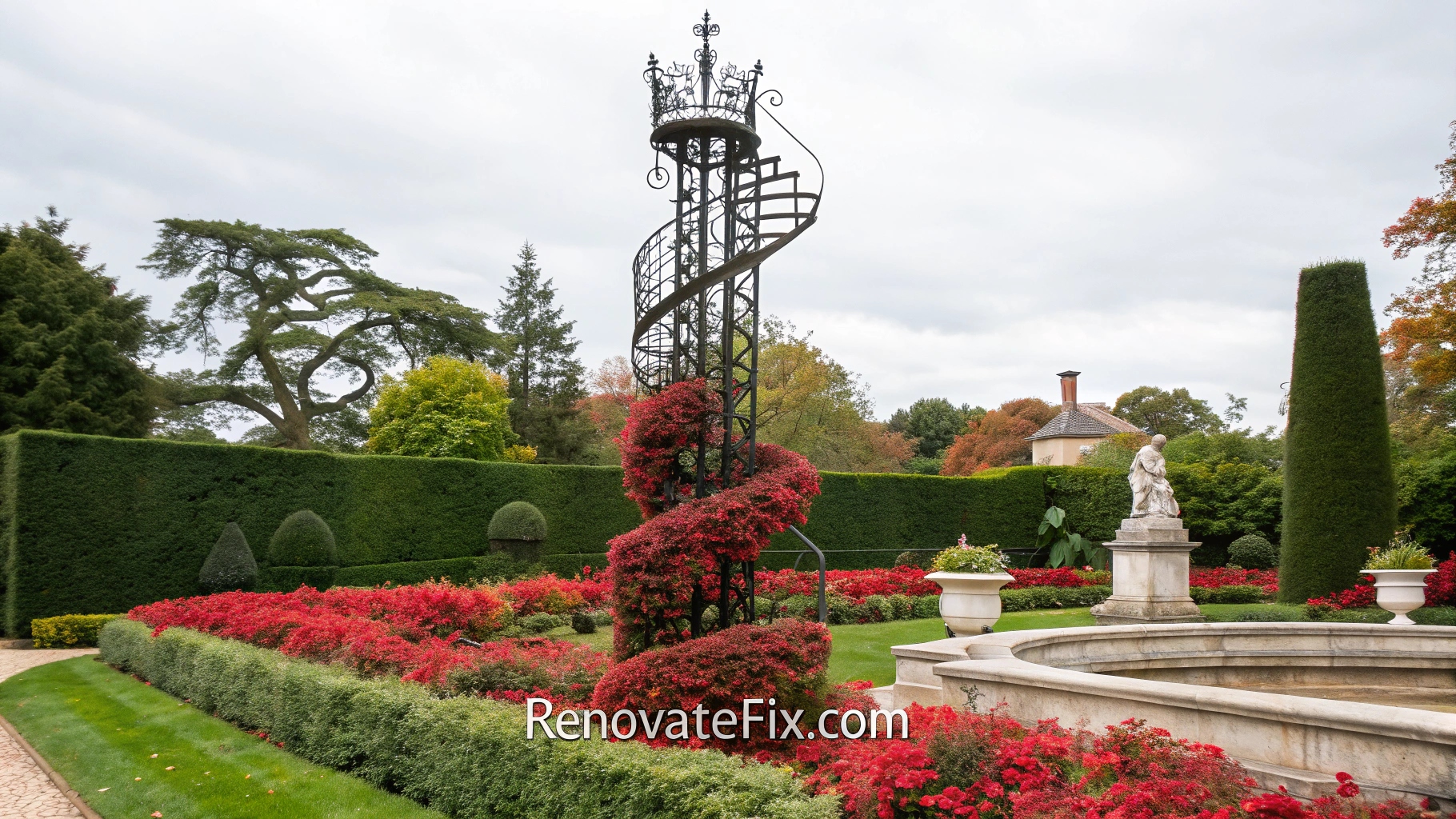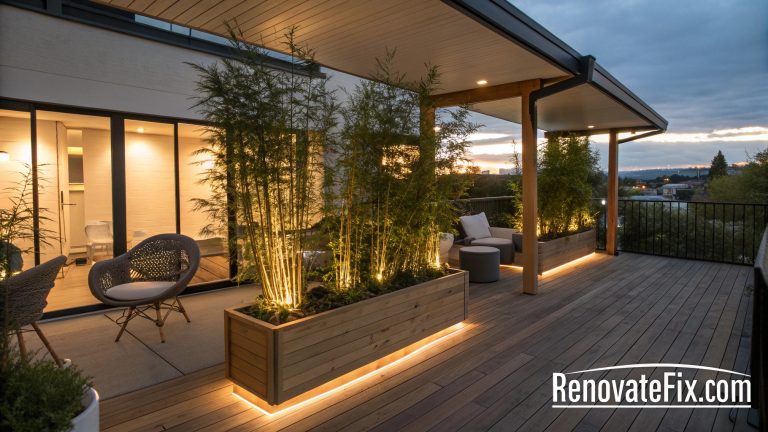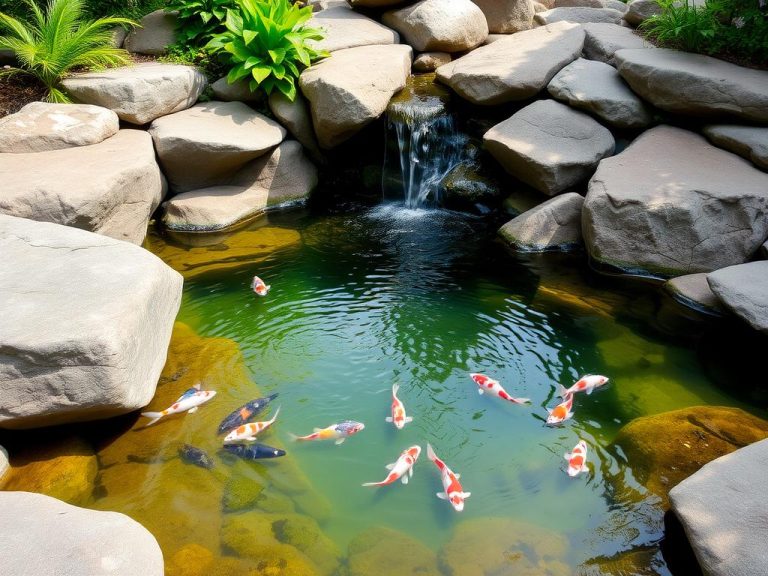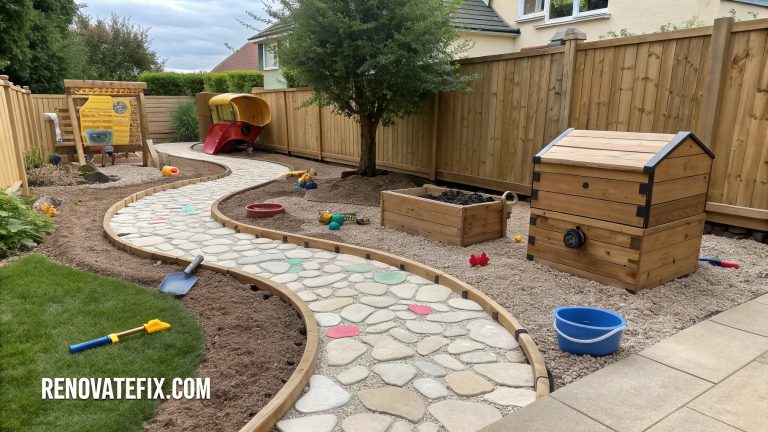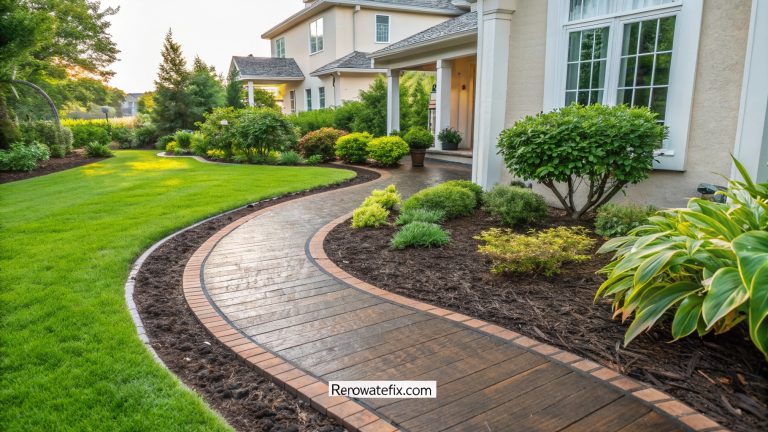15 Stunning Clematis Trellis Ideas for Your Garden
Clematis vines stand among nature’s most breathtaking flowering climbers, showcasing an impressive array of vibrant blooms that can utterly transform any garden space.
These magnificent plants require proper support structures to thrive and display their full splendor.
An ideal clematis trellis not only provides essential climbing support but also serves as a striking architectural element within your outdoor sanctuary.
Whether you’re working with a compact balcony or an expansive garden landscape, selecting the perfect trellis design allows these remarkable flowering vines to reach their full potential.
This comprehensive guide explores fifteen innovative and practical clematis trellis ideas that combine functionality with aesthetic appeal, helping your clematis plants flourish while enhancing your garden’s visual impact.
15 Creative Clematis Trellis Ideas
1. Repurposed Vintage Ladder Trellis
An antique wooden ladder positioned against a wall or standing independently creates a nostalgic support structure for climbing clematis vines.
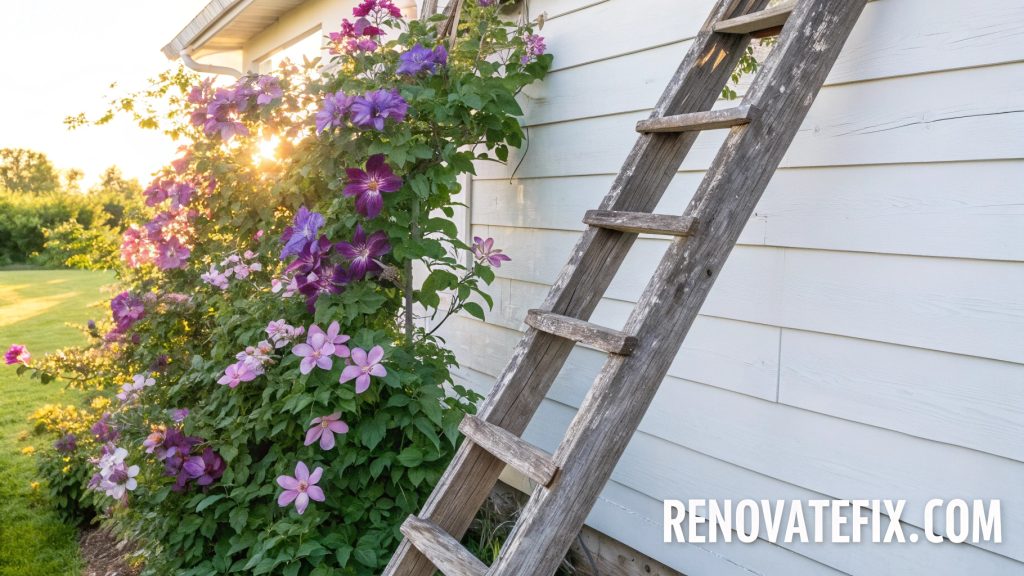
Weathered rungs provide perfect anchoring points where tendrils attach naturally, forming cascades of blooms that drape gracefully downward.
Horizontal spacing between steps allows adequate air circulation while presenting an organized display space that showcases various colors and varieties simultaneously.
Such rustic charm brings character and history into garden spaces while functioning superbly as a plant-supporting framework.
2. Arched Metal Arbor Pathway
A curved metal framework forming a garden walkway creates an immersive botanical tunnel once clematis establishes itself along its structure.
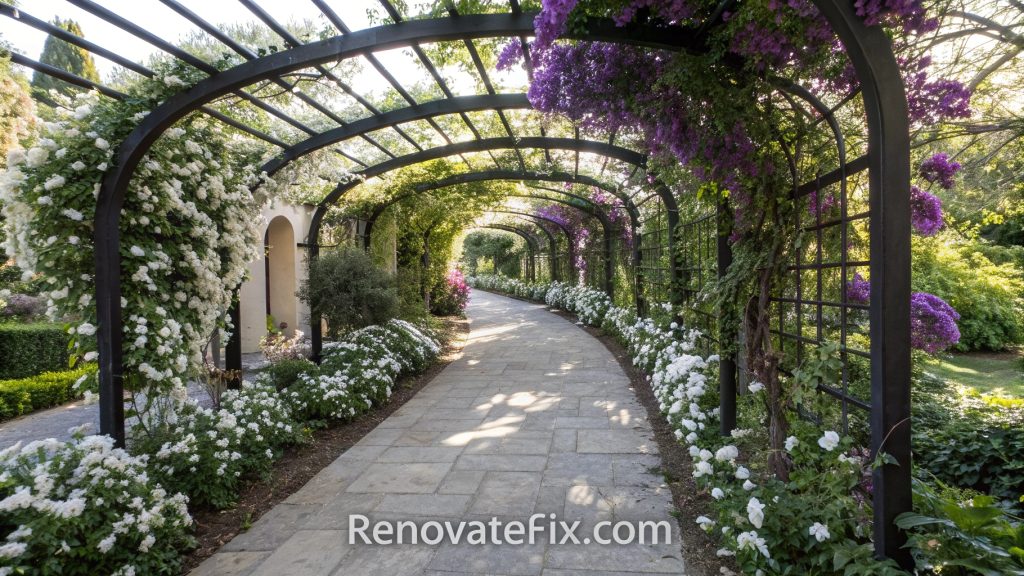
Visitors experience walking beneath canopies of hanging flowers that form overhead, providing dappled shade and sensory delight during summer months.
Strategic placement connecting different garden sections adds purposeful transition spaces while maximizing vertical growing opportunities in limited ground areas.
When multiple varieties grow together, staggered blooming periods ensure visual interest from spring through autumn.
3. Reclaimed Window Frame Display
Old wooden window frames mounted vertically against fences or walls present grid patterns perfectly suited for clematis training.
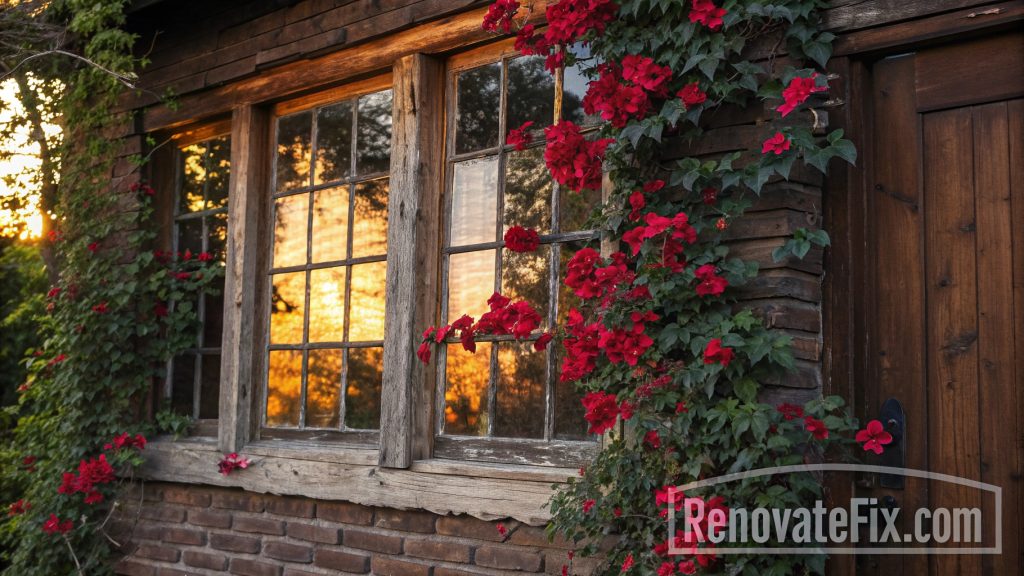
Each windowpane section becomes a framed living picture as flowers grow through openings, creating organized botanical artwork.
Vines weave through empty squares while blooms position themselves within frames, resulting in structured yet organic visual compositions.
Salvaged materials add sustainability aspects to gardening projects while providing sturdy climbing surfaces with built-in character and weathered patina.
4. Circular Hoop Support System
Round metal hoops arranged in ascending heights form sculptural plant supports resembling abstract art installations within garden beds.
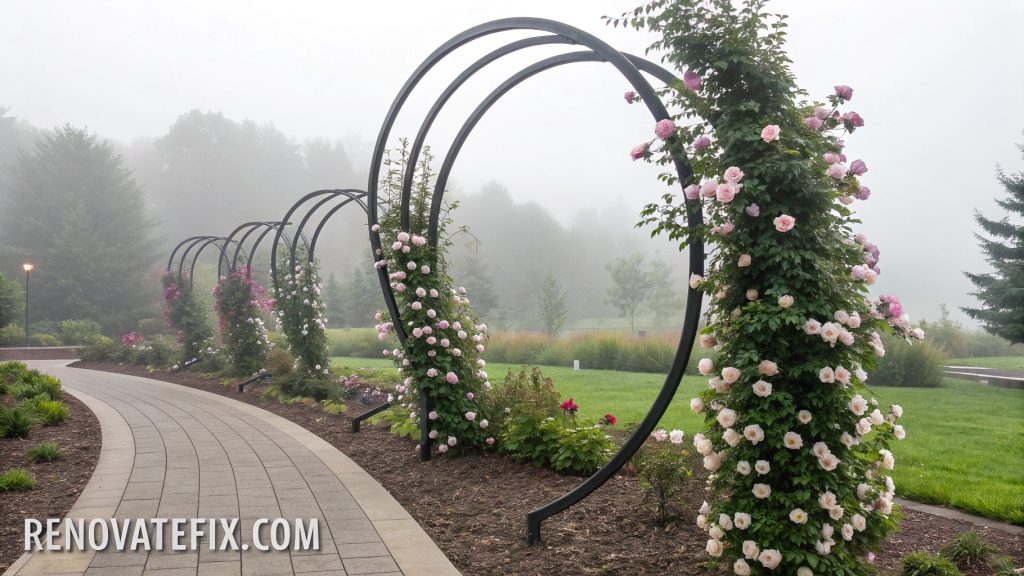
Clematis stems wrap around curved surfaces, creating botanical spheres that appear to float above ground level when filled with blooms.
Various diameters staggered throughout planting areas provide dimensional interest even before plants mature fully.
This minimalist approach suits modern garden designs while offering practical climbing structures that remain visually appealing during winter months.
5. Woven Willow Obelisk Structure
Hand-crafted willow branches interwoven into tall conical shapes bring organic architecture into garden spaces while supporting vigorous clematis growth.
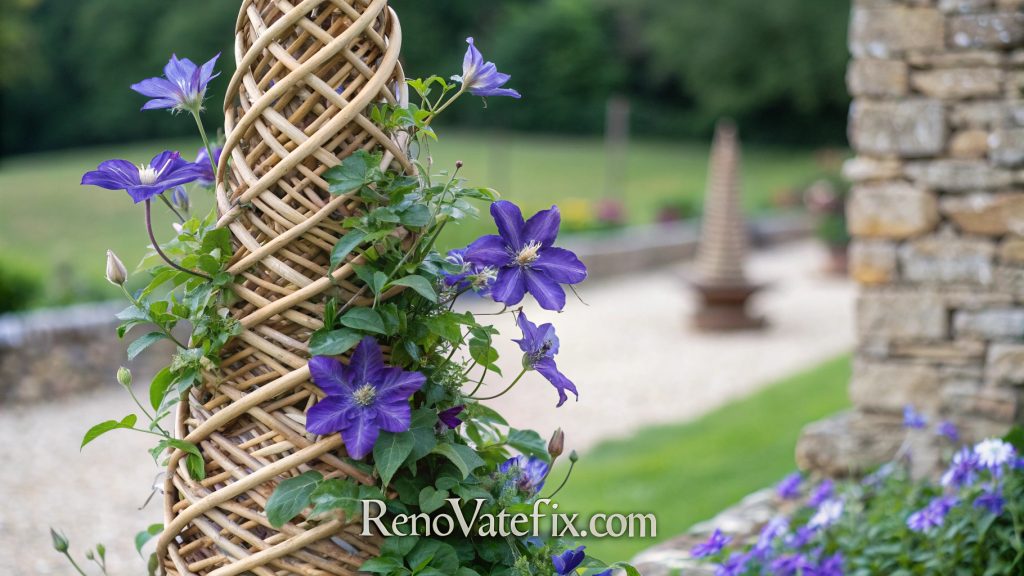
Natural materials blend harmoniously with surrounding plantings as vines intertwine among flexible willow stems. Each support develops unique character as both structure and plant mature together over seasons.
These biodegradable frameworks eventually become almost indistinguishable from plants themselves, creating unified living sculptures within perennial borders.
6. Copper Pipe Geometric Framework
Slender copper piping assembled into angular geometric patterns creates striking modern trellis designs that patina beautifully with age.
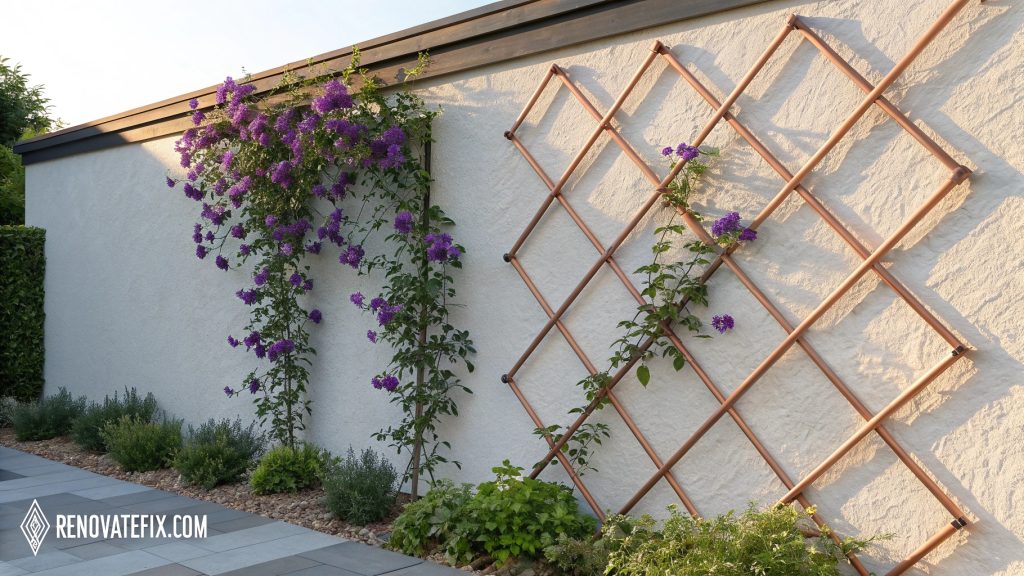
Mathematical precision in construction offers stark contrast against organic plant forms winding throughout rigid frameworks.
Oxidizing metal surfaces develop rich verdigris coloration complementing flower hues while providing strong structural integrity for heavy flowering coverage.
These architectural elements function equally well as standalone garden sculptures when plants retreat during dormant seasons.
7. Salvaged Iron Headboard Support
Vintage iron bedframes repurposed as garden structures provide intricate vertical surfaces where clematis varieties can climb freely.
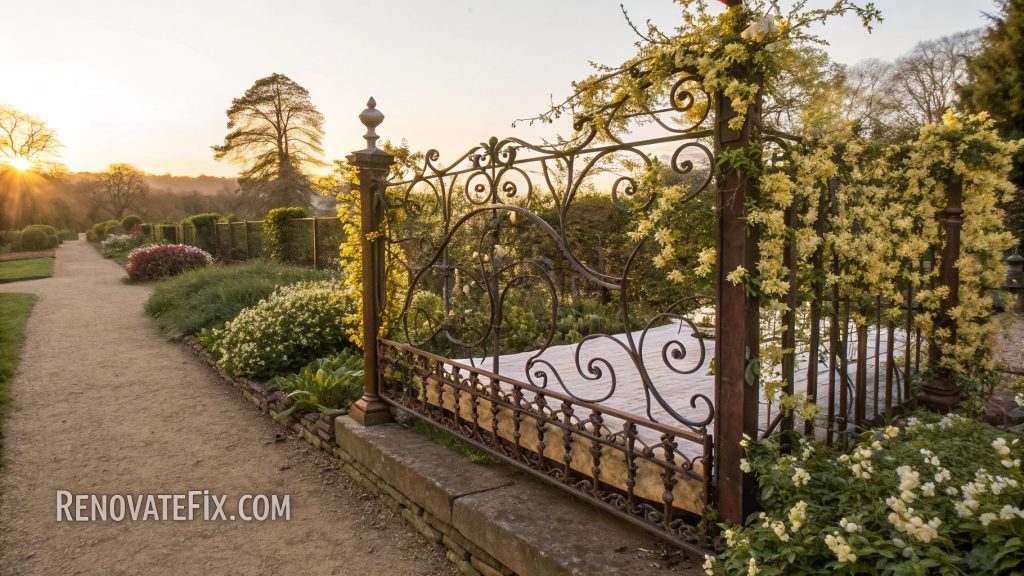
Ornate scrollwork characteristic of antique bed designs offers numerous attachment points for twining stems seeking support.
Positioning these unique frames along property boundaries creates distinctive garden dividers showcasing seasonal color progressions.
Historical elements brought into horticultural settings combine nostalgia with functionality while giving new purpose to discarded household items.
8. Fan-Shaped Bamboo Arrangement
Sustainable bamboo poles arranged in widening fan patterns create eco-friendly trellis structures with Asian-inspired aesthetics.
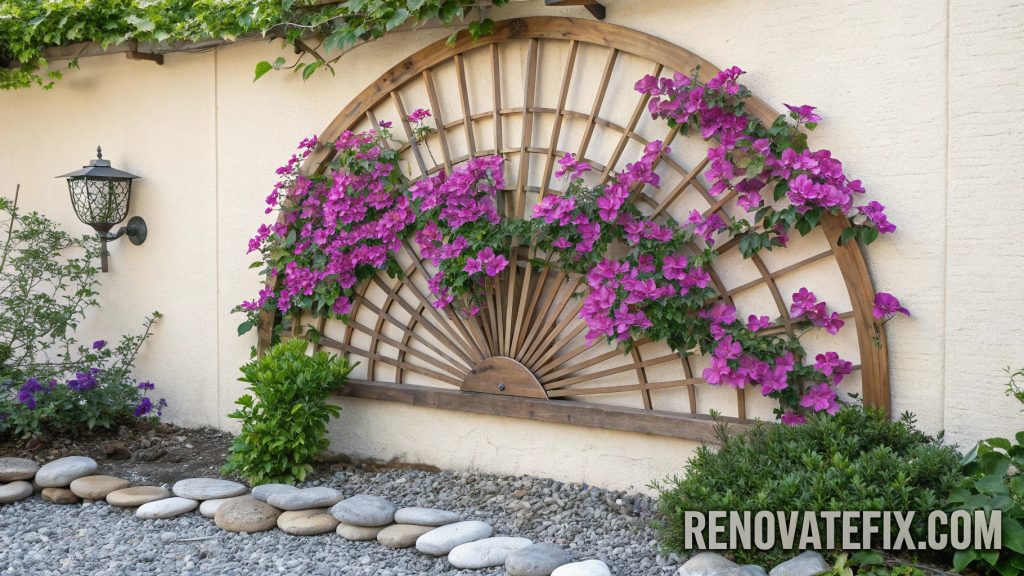
Natural materials weather gracefully over time while providing strong yet flexible support for vigorous climbing plants.
Radiating design allows multiple clematis specimens to grow outward from central planting point, maximizing display area.
This approach brings architectural elements reminiscent of traditional garden practices while using renewable materials compatible with environmental gardening principles.
9. Vertical String Art Installation
Colorful garden twine stretched between top and bottom supports creates geometric patterns forming living tapestries as clematis stems follow string pathways.
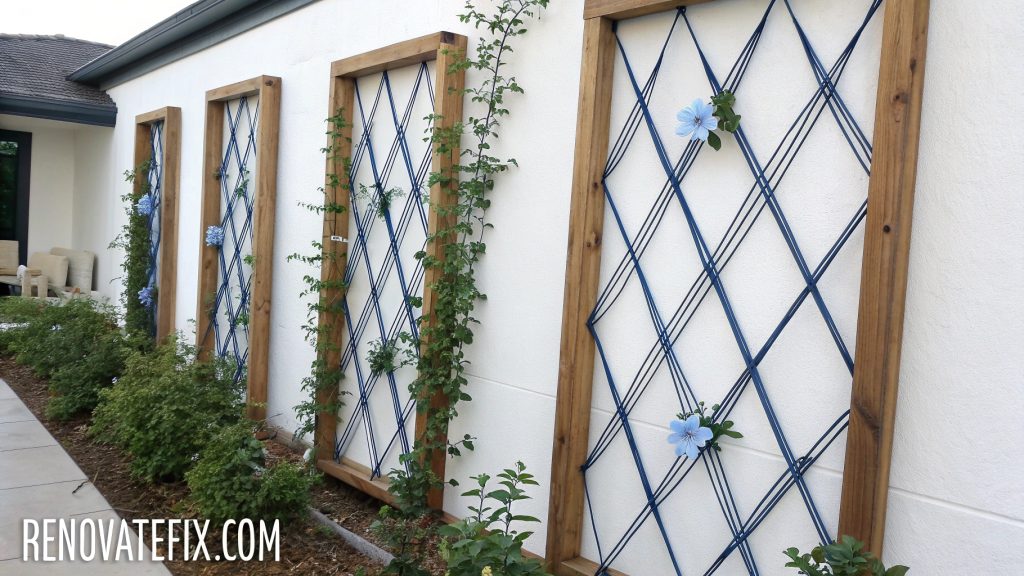
Mathematical precision in string arrangement guides plant growth into predetermined designs visible beneath flower coverage.
Multiple vines trained along different sections create planned color blocks that change appearance throughout blooming cycles.
This creative approach combines fiber arts concepts with horticulture while providing customizable growing systems for specific garden aesthetics.
10. Freestanding Branch Teepee
Collected fallen branches arranged into conical structures secured with natural twine create rustic clematis supports with woodland aesthetic appeal.

Varying branch thicknesses provide diverse attachment points where climbing tendrils find secure anchoring.
Organic forms blend naturally within cottage garden settings while offering sturdy frameworks for vigorous growth habits.
These biodegradable structures eventually contribute nutrients back into soil systems after several seasons of productive garden use.
11. Mounted Bicycle Wheel Display
Upcycled bicycle wheels attached securely to walls or fence surfaces create circular frameworks where clematis vines weave through metal spokes.
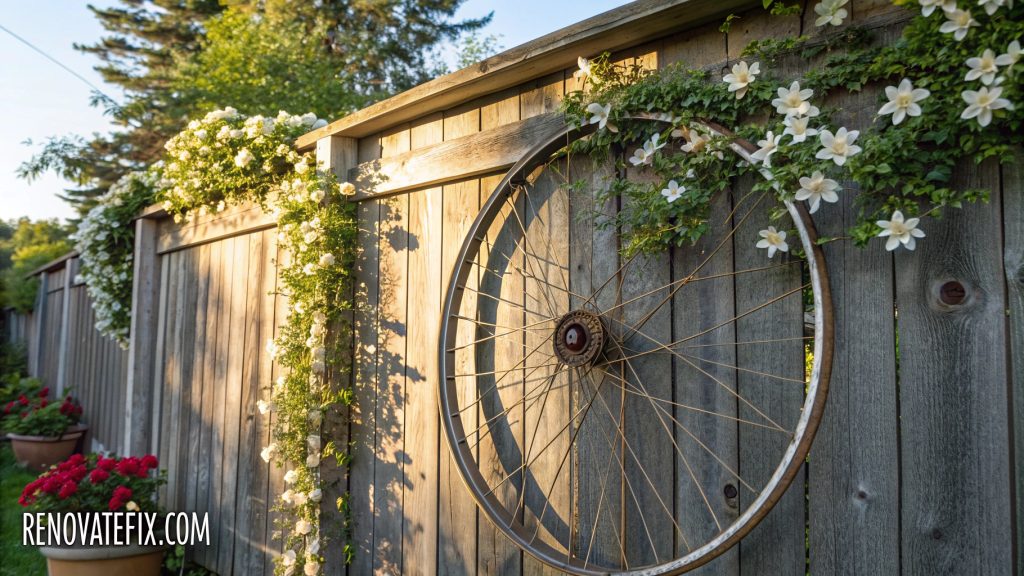
Industrial elements repurposed for garden use combine sustainability with visual interest through unexpected material applications.
Wheels of various sizes grouped together form artistic compositions while providing practical growing supports with built-in drainage spaces.
These conversation-starting structures showcase environmental creativity while functioning perfectly for climbing plant displays.
12. Driftwood Sculpture Support
Beach-collected driftwood pieces assembled into freestanding sculptures provide organic climbing structures with coastal aesthetic qualities.
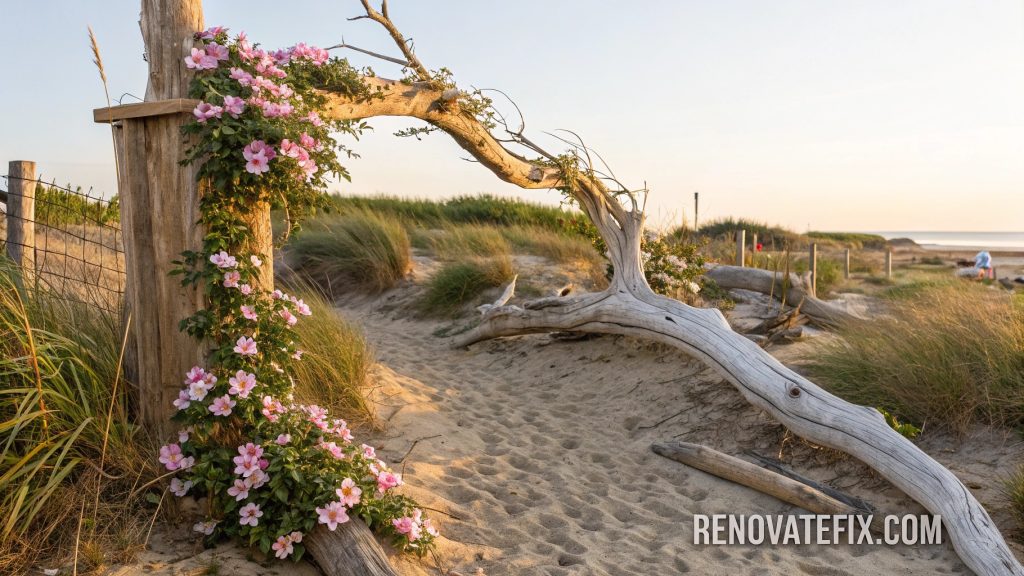
Weathered wood surfaces offer perfect attachment points for clematis tendrils seeking natural climbing opportunities.
Each unique structure brings artisanal quality into garden spaces while supporting vibrant flowering displays throughout growing seasons.
Natural materials with history and character enhance planting schemes while providing conversation-starting focal points within garden designs.
13. Hanging Chain Curtain System
Stainless steel chains suspended from overhead supports create curtain-like growing screens where clematis plants can climb vertically with minimal structural visibility.
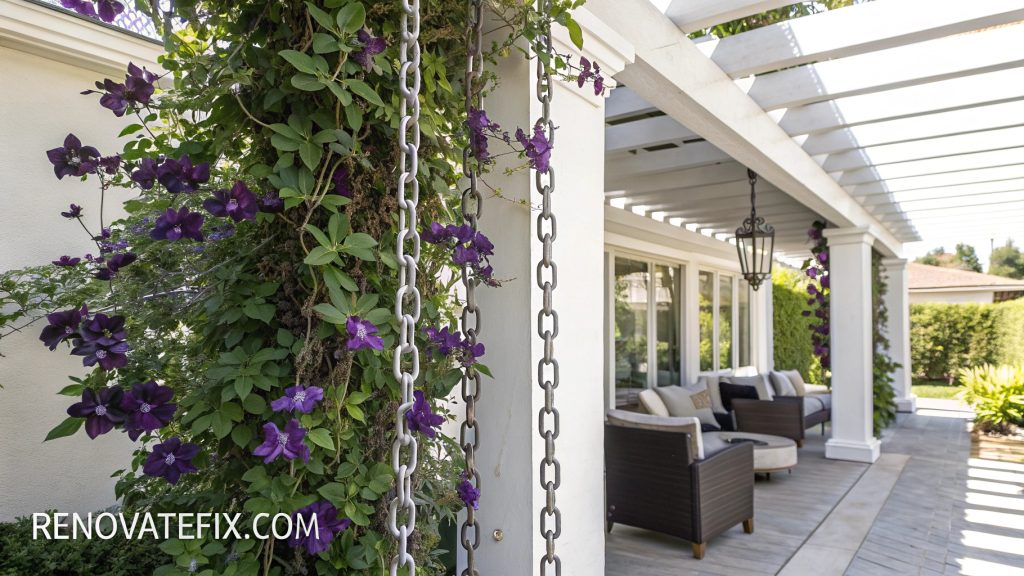
Metal links provide secure attachment points while remaining visually subtle beneath developing foliage coverage.
Movement possibilities during breezy conditions add kinetic elements to garden spaces as plants sway gently within flexible support systems.
This approach maximizes vertical growing opportunities within confined spaces while creating semi-transparent living dividers.
14. Spiral Wrought Iron Obelisk
Hand-forged metal spiraling upward creates sculptural clematis supports reminiscent of classical garden ornaments with modern twists.
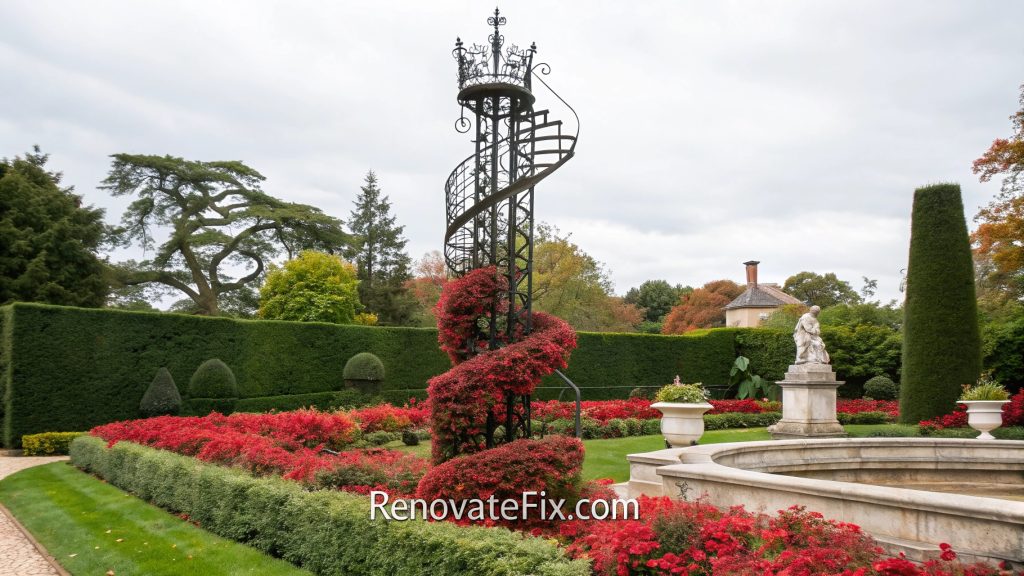
Twisting metal pathways guide plant growth naturally upward while providing strong structural integrity for mature vine development.
Artistic craftsmanship makes these supports beautiful garden features regardless of seasonal plant coverage.
Positioning these distinctive structures as focal points within planting beds draws visual attention while maximizing vertical growing space.
15. Living Willow Dome Structure
Living willow rods planted directly into soil and shaped into arched frameworks create growing structures that develop alongside clematis plantings.
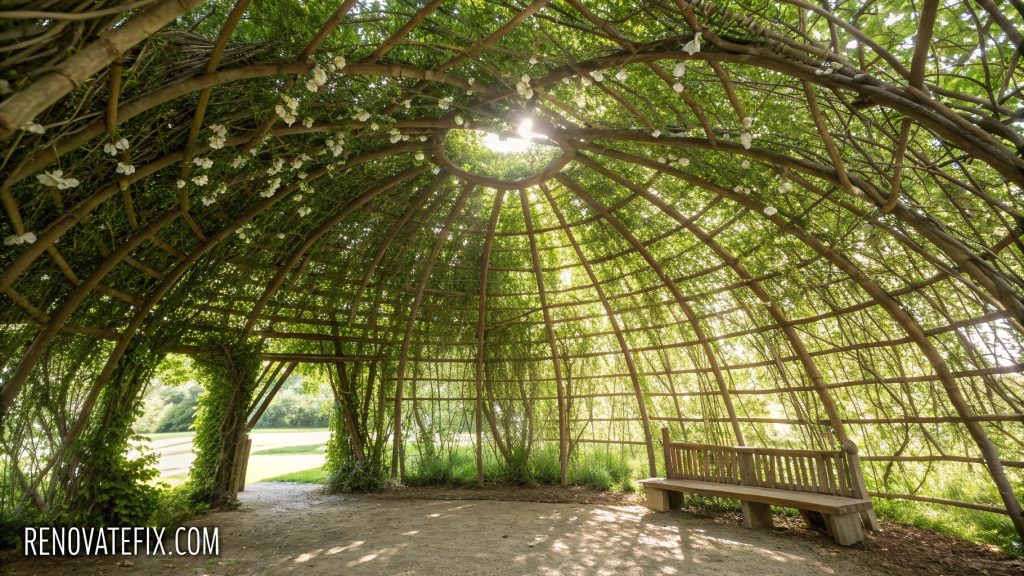
As willow stems root and leaf out, they form symbiotic relationships with climbing plants, creating truly integrated living architecture.
Seasonal changes bring dual interest through willow catkins followed by clematis blooms against green backdrops.
These bioengineered structures combine horticulture with architectural concepts while providing sustainable, growing frameworks that strengthen over time.
Conclusion
Selecting an appropriate trellis design for your clematis collection involves balancing practical support requirements with aesthetic considerations that complement your overall garden vision.
These fifteen innovative approaches demonstrate how functional plant supports can simultaneously serve as artistic garden features, enhancing outdoor spaces even during dormant seasons.
Whether your preference leans toward rustic natural materials, modern architectural elements, or repurposed vintage finds, there’s a clematis trellis solution perfectly suited to your garden style.
By providing proper climbing structures, you’ll enjoy more prolific blooming, healthier plants, and dramatic vertical displays that maximize your garden’s potential.
As these magnificent flowering vines establish themselves on thoughtfully designed supports, they create living sculptures that evolve throughout seasons, bringing continued joy and beauty to your outdoor sanctuary for years to come.

